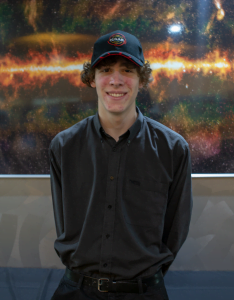
Oliver King
If Einstein was alive today, I bet he would work at ICRAR! It is one of the most exciting places to work if you love learning about the universe and how it was created. ICRAR is full of passionate engineers and astronomers who are exploring outer space using the most modern and precise technology to gather better and more accurate information about the universe. Most members of the general public probably imagine that like Galileo, astronomers spend their time looking through telescopes to learn new things about the universe and although optical astronomy is still relevant today, in modern times, many astronomers are now working with mathematical data, computers, frequencies and radio waves to measure such things as when clusters of galaxies collide, life of a black hole, what happened before the first star formed and investigating the Sun and its effect on Earth’s weather and infrastructure e.g. satellites, power grids and communication networks.
We are at really important point in history with significant implication in Western Australia, because in 2018 Curtin University lead the Murchison Widefield Array (MWA) and will begin at the CSIRO’s Murchison Radio-astronomy Observatory. This mega-science project will develop the world’s largest and most sensitive radio telescope. To be a work experience student at ICRAR at this point in time is very exciting and a great honour. The amount of data that is being gathered from the universe would be unimaginable to early astronomers.
My week at ICRAR was busy, satisfying and inspiring. Each day was very different from the other. So much happened that I couldn’t write it all down, but here are a few examples of the types of experiences I had.
- Attended PhD presentation of Pikky Atri where she explained her research on black holes. This was a fascinating presentation on a topic that the scientific community is only just beginning to understand about such a broad topic, it seems to me that the more we learn the more questions we have.
- I spent time with PhD students, Professors, engineers, and many astronomers. Learning about such topics as Epoch of Reionization, galaxies, the cosmic web, pulsar’s, neutron stars, dark matter, dark energy, gravitational waves, the SKA project, the MWA project, optical telescopes, coding, black holes, data intensive astronomy, solar fusion, space junk, spectrum of light waves, supernova’s, redshift, exo-planets, and radio telescopes.
- I was able to see up close the radio telescopes that are a part of the MWA and the SKA. I was very surprised at how small they were, they were all about half a metre high and wide. Each of them has two small amps that receive the radio frequencies. I also got to see the equipment that this data was sent too.
- I was fortunate enough to receive two tickets to ‘When Galaxies Collide’ by Prof. Lisa Harvey-Smith who is doing an Australia wide solo tour. She shared easy to digest information about the future of our universe.
I enjoyed learning about all the little bits of information that makes this industry so fascinating. For instance, neutron stars have such a high density that one teaspoon can weigh 10 million tons, and that the star can rotate 716 times per second. I really loved interacting with real astronomers because this is the career pathway I wish to follow. I appreciated all the help I got from the PhD students who helped me clarify my subject selection for ATAR. I particularly wish to thank my supervisors, Greg Rowbotham and Pikky Atri.
For me, ICRAR is a synergistic blend of cutting-edge technology, human curiosity, ambition and passion. I hope to be back at ICRAR one day in the future contributing to this mega-project.